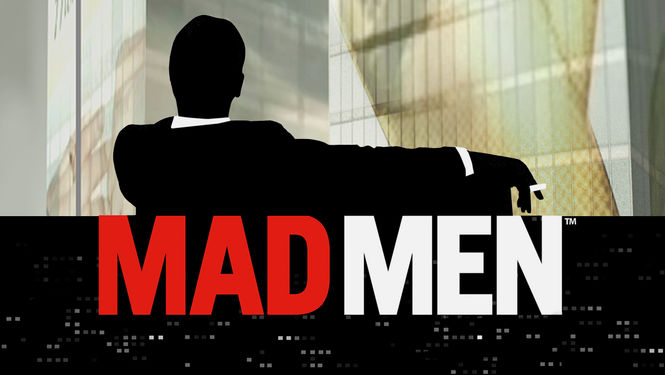Last month marked the end of an era, as we saw the curtains close on one of the finest drama series’ ever to air on television, at least in the recent times – Mad Men (if you haven’t watched it, you should). The show might be over, but the marketing community’s love affair with it, and the most suave fictional ad man in history is clearly not – hordes of tribute articles still being published are a proof.
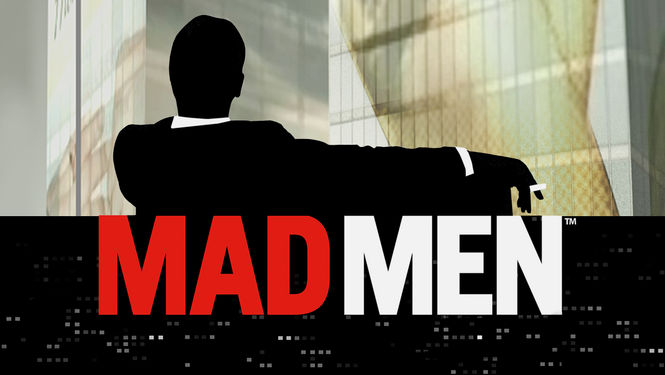
Admiration works in weird ways. For me it was fascinating to watch Donald Draper struggle with his deep seated personal issues, and his past, while never letting the struggle affect his work, at least not until the downward spiral of his decline got painfully prominent.
We all saw his creative genius, his rise, his decline, the revelations and finally the one epiphany that stuck, but there is one common reason why the modern marketing community was so in love with him – he was incredibly good at what he did. From time to time he shared great marketing tips that still hold true for marketers everywhere. Let’s look at some of Draper’s words of wisdom, and how they hold true for our world of marketing as well as it did in the ‘60s.
1. People
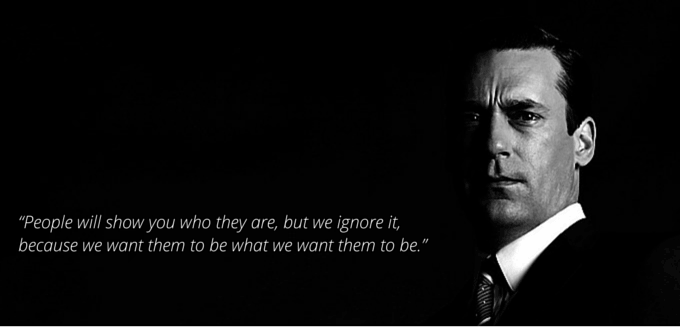
“People will show you who they are, but we ignore it, because we want them to be what we want them to be.”
Our world of business differs vastly from Draper’s, but the ad man’s most quoted line stands truer today than in his own time. Unlike that time, our marketing is completely technology led (at least it should be), and it is ridiculously easy for us to collect data about everything. People leave their footprints everywhere they go online; they tell us who they are explicitly (through lead capture forms, social media, feedback forms etc.), and implicitly (as we track their movement across the website and interactions with other aspects of our marketing.)
Yet, we act on assumptions about our audience, and try to connect with them in a very generic manner. Because, that’s incredibly easy to do. But that wouldn’t get us great results.
Instead, if you listen to your audience, and understand their behavior, you would be able to make a much better and profitable connection with them.
We are already sitting on incredible amount of raw information – but it is for us to collate that data and draw meaningful behavioral patterns from it.
2. Change

“Change isn’t good or bad. It simply is, it can be treated with terror or joy.”
Change is frequent in anything led by technology. We all see new social media platforms emerge, and decline. Google continually modifies its algorithm to improve search experience.
Whenever there is a new change, there is a general outrage that we witness – and it’s inevitable. Every change throws marketers off their games a bit.
But as soon as the aftershocks of the supposed disaster pass, the marketers that emerge victorious are the ones that go with the flow, and face the change, instead of moping around and closing their eyes to what’s going on around them.
It’s easy to stay adamant, and say, that’s how we have always done things, but it’s also completely fatal for a business.
Let’s think about mobile-friendliness of a website for a second. A business that gets a significant amount of its traffic from mobile, but chooses to not switch to a mobile-friendly design would definitely suffer in the long run. It’s a change, but businesses need to learn to embrace it.
3. Strategy
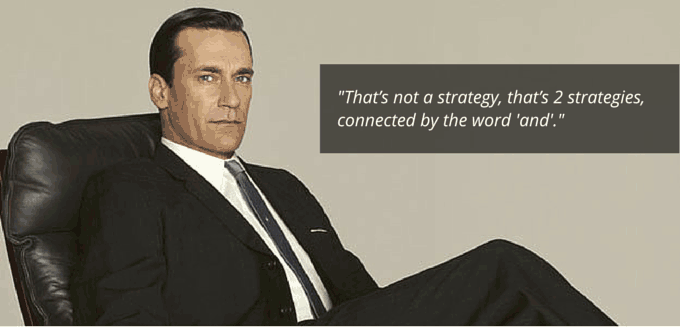
“That’s not a strategy, that’s 2 strategies, connected by the word ‘and’.”
All digital marketers are conversion optimizers. Be it a social media post, a blog, an ad copy or a landing page, we are all striving to get better results.
There are 2 rules for every successful campaign:
- Identify who you want to target – your audience.
- Identify the offer that would resonate with this audience, and focus the campaign on just that “one” thing.
You cannot try and sell to two different demographics in one single search or display campaign.
And, you cannot try and sell two different offers in “one” campaign to that audience either.
You would have seen campaigns trying to do everything on one landing page. Buy a course “or” Get free video lectures “or” Subscribe to the newsletter.
If you do this, you are disrupting focus, creating friction, and making people think again about why they are on your landing page at all. They clicked on the ad, because they probably thought your course seemed cool and wanted more details. But, you gave them another option in the form of free videos as well. Now, they might just sign up the free course, and not buy your course, till at least later.
So, go by one strategy, not two connected by the words “and” or “or.”
4. Technology

“Well, technology is a glittering lure. But there’s the rare occasion when the public can be engaged on a level beyond flash – if they have a sentimental bond with the product.”
With all the props Mad Men has received for portraying the cynical world of advertising in the ’60s accurately, one problem that the critics often found was the mediocrity of the “winning” pitches. The Kodak carousel pitch, where this line comes from though, was good, and probably the show’s strongest.
Your product might be great, but that alone would not win you loyal customers.
It’s the relationships your people are able to build that would create the sentimental bond – the salespeople who strive to understand the individual needs of prospects, instead of concentrating on just making a sale, a support team that is quick, prompt and effective, and the whole company making the customers feel they are important even post-acquisition. That’s what you need.
So, invest on these winning people.
5. Story
“When a man walks into a room, he brings his whole life with him. He has a million reasons for being anywhere. Just ask him. If you listen, he’ll tell you how he got there.”

I know this is not how Draper meant this, but this is how I am choosing to interpret it for the purpose of this post.
When someone shows an interest in what you have to sell, he’s chosen to be there while blocking out everything else.
Respect the time he took to do it. If he clicked on your ad, while neglecting all the others, the experience on the landing page, therefore, has to be according to whatever he clicked the ad for. Finally, if he takes an action, by filling your form, you have to respect that by giving him a consistent experience. Deliver what you promised, otherwise you would just leave a sour taste in his mouth, and you don’t want that for someone who took enough interest in you.
6. Advertising
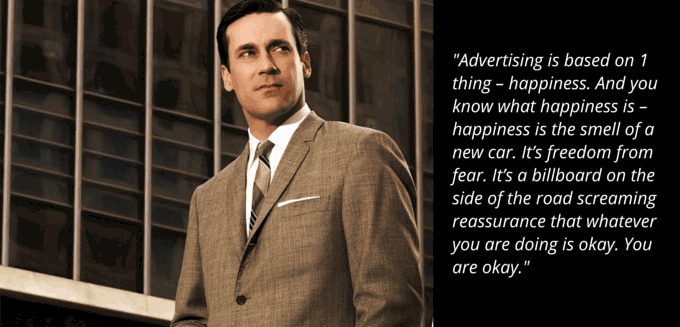
“Advertising is based on 1 thing – happiness. And you know what happiness is – happiness is the smell of a new car. It’s freedom from fear. It’s a billboard on the side of the road screaming reassurance that whatever you’re doing is okay. You are okay.”
People don’t buy things; they buy the idea of making their lives better with it. They buy the idea of happiness.
That’s why they need reassurance that the decision that they are going to make is good. They need a seal of approval from others they can relate with. Give them this seal of approval in the form of testimonials, case studies and success stories from real people who share the same fears and same concerns as them.
7. Success

“Even though success is a reality, its effects are temporary.”
So what that you closed a new deal – no doubt you got success. But, unless you follow-up this success with great support and customer service, your clients aren’t going to stick.
Invest on post-acquisition support and nurturing. Send your customers valuable information they can use, and give them the support no one else has been able to. That’s when the success would be a long-lasting reality for the business.
8. Customers
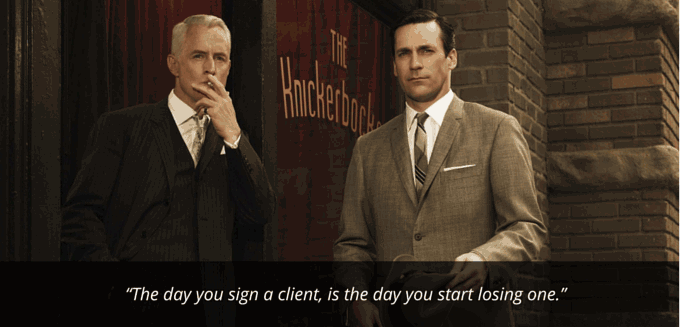
“The day you sign a client, is the day you start losing one.”
This once again emphasizes on the fact that you cannot afford to take a client for granted. It’s their business, and they can choose to take it anywhere they want, if they are not happy with what you have to offer.
So, you need to strive to keep these clients on board continuously by providing them the best of your support and service.
9. Problem-solving
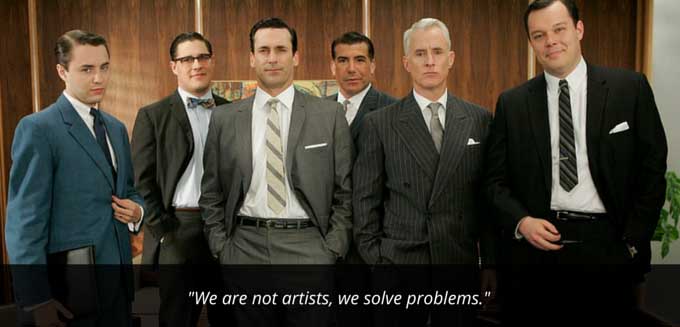
“We are not artists, we solve problems.”
This stands true in every aspect for advertisers and marketers everywhere. You might come up with the most creative campaign, but if your campaign doesn’t help the sales, or the brand identity, or whatever was the goal of your campaign, it’s a fail.
The big man, Ogilvy also said it very well – “If it doesn’t sell, it isn’t creative.”
There are several examples of creative ad campaigns that actually ended up hurting the sales of the product they were advertising. Several cases also include ads that were so outstanding that the audience remembered the campaign, but didn’t recall the product being marketed.
Digital marketers also should keep this in mind, and test what works for them – a clever ad or a clear one. In the end it all boils down to what sells better, and helps you achieve the objective of your campaign.
10. Anticipation
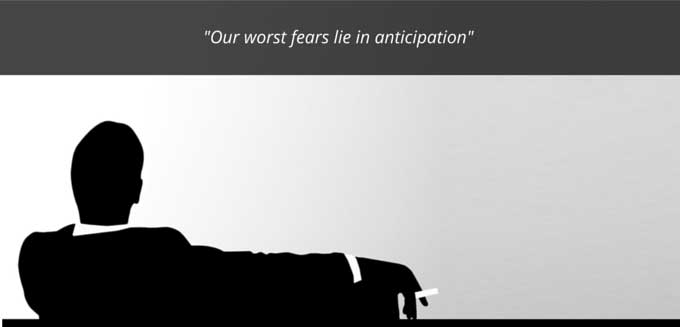
“Our worst fears lie in anticipation.”
It happens often that you are often so caught up in crafting the perfect campaign, or the perfect blog post, that the actual implementation of the campaign or the actual launch of the post keeps getting pushed back indefinitely.
One thing that the marketers need to rise above is the fear of how their campaign would be received by the audience. I am not saying that you should push out a not-thought-through campaign or a half-baked post, but you need to know when to actually hit “Publish” instead of waiting for the implementation to be perfect. You’ll not know how it will be received, until you actually make it live, would you? If it fails, learn from it.
Bonus Quotes – Sterling’s Gold
Draper was the creative genius, but account man Roger Sterling never failed with his one liners either. Let’s look at present day sales from his perspective.
11. Customer relationship
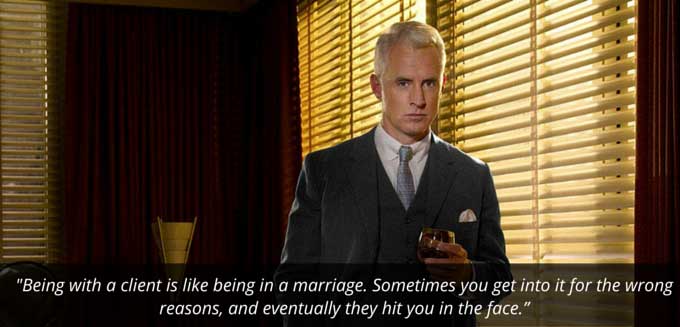
“Being with a client is like being in a marriage. Sometimes you get into it for the wrong reasons, and eventually they hit you in the face.”
The reason why convince or confuse doesn’t work anymore in sales – at least it shouldn’t. The best sales people now are not the ones who can sell a product to people who don’t need them.
If you sell to someone who doesn’t want your product, the relationship would eventually end, because you were in it for all the wrong reasons. You tried to make a sale, without considering the customer’s benefit. They would eventually realize this – they aren’t fools after all.
“The consumer isn’t a moron. She is your wife.” – Ogilvy
12. Sales pitch
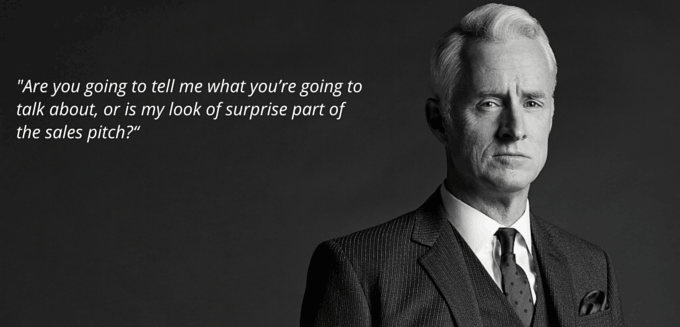
“Are you going to tell me what you’re going to talk about, or is my look of surprise part of the sales pitch?”
Be prepared when you are making a sales pitch – research the prospect properly before you actually get on a call with them. Tracking software in place would help your cause here.
A prospective customer would trust you if they believe that you understand their needs inside out – the only way to not get caught off-guard by their questions is actually doing your homework.
So, that’s it. That was my share of favorites from Mad Men’s incredible marketing wisdom. Why don’t you share yours too, while I go get an old fashioned. Again, if you haven’t watched it yet, I hope this post convinces you to.





